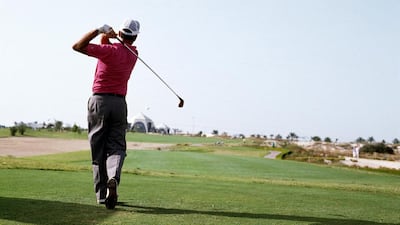It would have been so typically Dubai, only Dubai back then was nothing like it is today.
On Tuesday, March 8, 1988, in front of a gallery that included all seven of the UAE’s Crown Princes, the president of Pakistan, four of the planet’s top golfers and media spanning the globe, the world champion parachute team descended upon Emirates Golf Club to deliver a special gift.
After landing expertly on a small, white cross just in front of the driving range, the UAE regiment’s leader unstrapped a gold-plated driver from his leg and presented it to Pakistan’s premier, Zia-ul-Haq, on the first hole. A ball was then placed on a gold tee peg and, with one full swipe, Zia launched it out into the Majlis golf course. In doing so, Emirates Golf Club officially had lift-off, too.
“We were all praying he’d hit this ball and not miss it,” says Rod Bogg, then the club’s general manager. “But he smacked it right down the middle. Turns out he was a quite a keen golfer.”
At the time, he would have been in the minority. Golf in the Gulf was still in its infancy, let alone golf in Dubai. Construction of Emirates Golf Club had begun less than two years previously; it provided the Middle East with its first championship golf course.
Born from the realisation that Dubai’s oil and gas reserves were finite, and that sport and tourism instead would drive a sustainable economy for the future, it followed other new enterprises such as Emirates Airline, Jebel Ali Free Port and the World Trade Centre.
So, on a patch of desert 25 kilometres from the emirate’s centre, Sheikh Mohammed bin Rashid, now Vice President of the UAE and Ruler of Dubai, commissioned the development of the club. The course was designed by Karl Litten, and the clubhouse – made of up of seven majlis to reflect the country’s seven emirates – was devised by local architects Brewer Smith and Brewer. Al Naboodah Laing, another Dubai-based company, carried out the construction.
Meanwhile, there was nothing around it; a veritable oasis in the desert.
“I remember going up in a helicopter in 1986,” says Tony Lewis, a journalist at that time, who two years later was running public relations for the opening. “It was like someone just dropped a green mat in the desert.”
Soon, some gloss was added. To mark the launch in 1988, an East-West Challenge was devised to consecrate the club and advertise Dubai as a hub for tourism and business. Graham Marsh and Rodger Davis, the Australian professional pair, comprised the East side, taking on Britain’s Sam Torrance and Howard Clark in the final of a four-day exhibition.
But it was Zia’s presence that created the greatest stir. His stance against the Soviet Union’s invasion of neighbouring Afghanistan meant the Pakistan president was a prominent figure in the news then, and thus his attendance attracted media from across the world.
After he holed his putt in the first green – reports vary as to what he scored – Zia turned to face the onrushing international press. Not everyone, though, was interested in hearing his thoughts on the new course.
Lewis recalls: “The first guy was from CBS or NBC in America, who shoved a microphone in Zia’s face and said ‘Hi Mr President, so what about the situation in Afghanistan?’”
A more convivial, sporting stand-off was settled on the 18th green, when Torrance holed a short putt to win it for the West. During the prize-giving ceremony, as the players praised the golf club and course, Marsh offered a caveat. It was a wonderful track, he said, but he could not envision that a professional tournament would commit to coming. Yet within 12 months, what became known as the “Major of the Middle East” arrived in Dubai.
“Very soon, the question was answered,” Lewis says. “The European Tour was on its way and what is now the Dubai Desert Classic was born. The rest is history, as they say.”
David Cannon has chronicled the narrative more than most. A highly respected golf photographer, he initially shot the embryonic Emirates Golf Club in 1986, when the only demarcations were a few lake linings in the sand.
Then again, Dubai was pretty incipient overall then.
“Sheikh Zayed Road was that tiny single lane with lorries chugging up and down on their way to Abu Dhabi,” Cannon says. “It took a long time to get to the course from our base at the World Trade Centre – it was the only building above three floors.”
Even then, Cannon knew something remarkable was afoot. Sure enough, the region’s first professional golf event was about to take flight.
“It was just excitement because you knew there was a lot of money being pumped into it, right from the business-class tickets on that Emirates EK001 out of Gatwick,” he says. “You could tell from the off it would be something special, that a lot of thought had gone into it. This was no gimmick.”
Maybe the gimmickry was left to the club’s inauguration. The gold driver was placed in a presentation box and given to Zia, who died less than six months later, by Sheikh Butti Al Maktoum, the club’s chairman. As for the gold tee peg?
“We don’t know what happened, but it disappeared” Bogg says. “Someone has it somewhere as a rather nice souvenir.”
Follow us on Twitter @NatSportUAE


